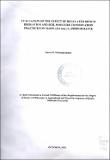Evaluation of The Effect of Regulated Deficit Irrigation and Soil Moisture Conservation Practices on Maize (Zae Mays) Performance

View/
Date
2018-08Author
David M., Mshimiyimana
Type
ThesisLanguage
enMetadata
Show full item recordAbstract
Though it is argued that the soils in most of Kenya's marginal rainfall areas have high potential for agriculture, low soil water constitutes a major limiting factor for crop production. Irrigation is one of the options used in such areas when ample water is available but it requires some adjustments when water is limited. Unfortunately little research has been done locally to understand how deficit irrigation can be used as a strategy for water conservation in those areas. This study investigated how regulated deficit irrigation and water conservation practices affect the growth, yields and water productivity of two maize varieties. The study consisted of a greenhouse experiment carried out at Kithoka, Meru County and field experiments at Marimanti, Tharaka Nithi County and Mailisaba, Isiolo County. Two irrigation treatments deficit irrigation except during exponential growth stage (DIE) and deficit irrigation except during the reproductive stage (DIR)) were compared to two controls (full irrigation throughout the season (Fl) and deficit irrigation throughout the season (DI)). Two irrigation schedules (half of the weekly water requirement applied per week (HA) and weekly water requirement applied every two weeks (DII)) were evaluated in the greenhouse experiment. Other treatments tested were ridging compared to a control (flatbed) and a superabsorbent polymer (SAP) compared to a control without SAP. Two maize varieties were used (DUMA 43 and KDV 2). Growth parameters measured were plant height and plant diameter measured every 15 days from 30 days after sowing. Yield indicators were stand count, number of productive plants per plot, ear diameter and length, above ground biomass, grain yield, and harvest index. The data collected was summarized in MS EXCEL and analyzed using SPSS version 22 for F-test, Post-hoc tests at a=5% and linear regression where necessary. FI gave significantly higher plant diameter (2.206 cm), plant height (148.02 cm), and grain yields (3019 kg/ha). DIR gave significantly higher harvest index (0.4665). Water productivity was the same for DIE, DIR and FI (0.5082, 0.4987, and 0.4828 respectively). Ridging had significantly higher values for above ground biomass (165.85 g), grain yield per plant (70.83 g), total grain yield (2419.6 kg/ha), harvest index (0.4283) and water productivity (0.5026 kg/m '). SAP had a significant effect on grain yield (2359.1 kg/ha) and on water productivity (0.4891). The highest yields were given by FI combined with ridges (3194.4 kg/ha) and FI combined SAP (3148.9 kg/ha). DUMA 43 gave significantly higher yields under DIE and DIR (2469.7 kg/ha and 2524.3 kg/ha) and better water productivity (0.5510 kg/m ' and 0.5310 kg/m ') compared to KDV 2. The study concluded that regulated deficit irrigation affects significantly maize growth, grain yields, and irrigation water productivity and the interaction between regulated deficit irrigation, ridging and SAP has a significant effect. Regulated Deficit Irrigation was recommended as a viable practice when water for irrigation is limited. Further research can be undertaken on the effect of different rates of SAP on maize growth, yields and water productivity under regulated deficit irrigation.
Publisher
KeMU
